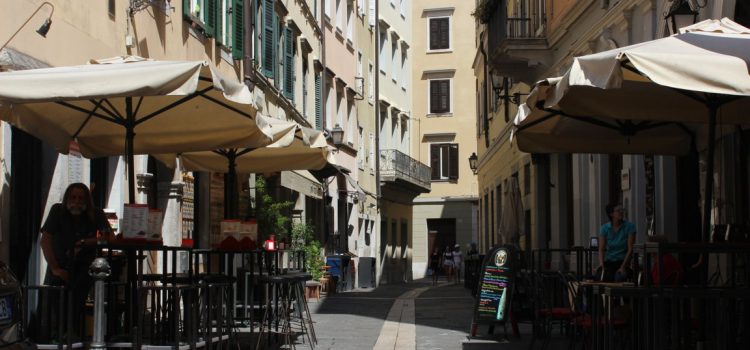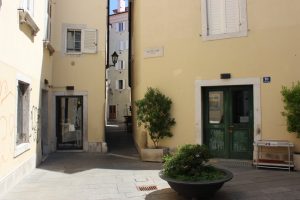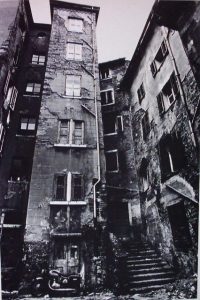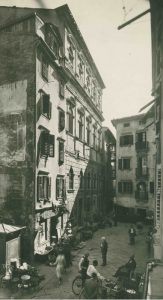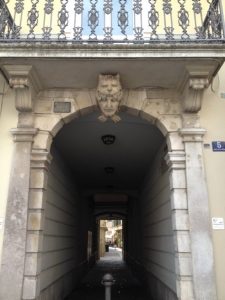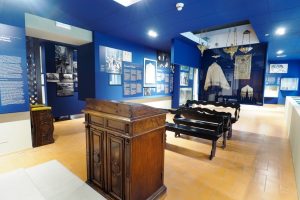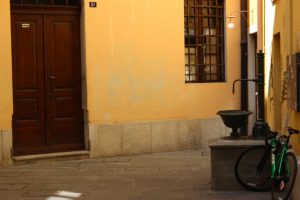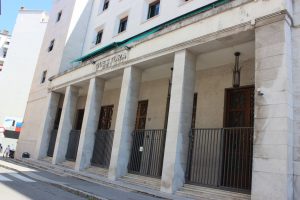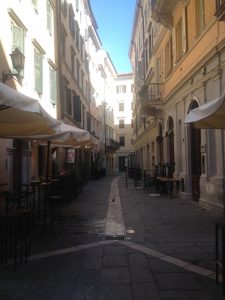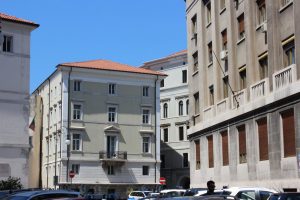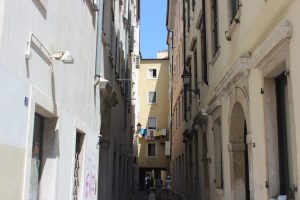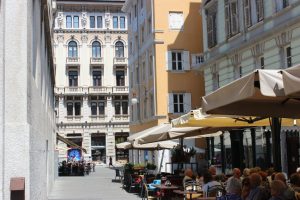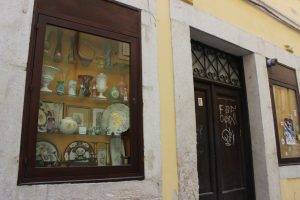.
Fu istituito da Leopoldo I d’Asburgo nel 1696 nell’area allora periferica di corte Trauner e il 28 novembre 1696 con decreto imperiale, fu trasferito a Riborgo, il cuore commerciale di trieste, accogliendo le proteste della comunità ebraica che voleva essere più vicina ai luoghi dove si svolgeva la vita economica della città.
Alla popolazione ebraica sono assegnate 13 case intorno alla piazzetta, detta delle Scuole ebraiche, e lungo due contrade parallele che dividono il quartiere in direzione nord sud. Nel 1697, requisite altre case, entrarono nel ghetto un centinaio di ebrei.
Al ghetto si accede dalla Portizza ed è circondato da un alto muro con tre porte d’ingresso: in piazza del Rosario, in fondo a via Beccherie e a Riborgo, all’epoca vigilate notte e giorno dalle guardie cristiane.
La proclamazione del porto franco di Trieste nel 1719, a opera di Carlo VI d’Asburgo, porta con sé privilegi e libertà per tutti e anche per la comunità ebraica sempre più numerosa e che assume, con il fiorire dei traffici e dei commerci, un ruolo centrale nella città.Nel 1748 venne costruita la prima sinagoga, la Shola n.1,di rito tedesco, distrutta da un incendio nel 1822. Fu ricostruita tre anni dopo e rimase attiva fino al 1935 come oratorio. Nel 1771 Maria Teresa concede infine agli ebrei di Trieste due Patenti sovrane, veri e propri regolamenti che prevedono, tra l’altro, l’esenzione dall’obbligo di indossare il segno giallo distintivo e l’abolizione della tassa speciale sulla persona (Leibsteuer), che doveva essere pagata da ogni ebreo per entrare in un’altra città.Nel 1784 l’imperatore Giuseppe II istituì le Patenti di tolleranza.Gli ebrei sono così ammessi alla carica di deputati alla Borsa, all’esercizio di attività professionali fino allora vietate e all’università e, l’anno successivo, fu abolita la segregazione.Furono costruite altre sinagoghe che vennero distrutte insieme a buona parte dell’antico ghetto durante il risanamento effettuato dal fascismo dal 1928 al 1937.
Dalla demolizione delle sinagoghe sono stati conservati degli oggetti di culto conservati nel Museo di Carlo e Vera Wagner in via del Monte 7.Fra il 1797 e il 1813 Trieste subisce per tre volte l’occupazione delle truppe napoleoniche, che segna per gli ebrei la conquista dei diritti.
Androna del Pane nominata così per le venditrici del pane le Servolane che arrivavano in città con le loro ceste di pane caldo.Androna del Pane era nominata anche Androna della Rizza che era il nome di una prostituta che abitava nell’Androna ed era molto conosciuta nell’ambiente. In queste stradine di Cittavecchia c’erano circa 40 case di tolleranza e più di 350 prostitute che esercitavano il mestiere, tutte regolarmente schedate e con l’assistenza sanitaria. La minuscola casa di tolleranza chiamata “Il metro cubo” è forse adombrata in una lettera di Joyce a Svevo in cui lo scrittore irlandese ricorda “i postriboli di pubblica insicurezza” della zona.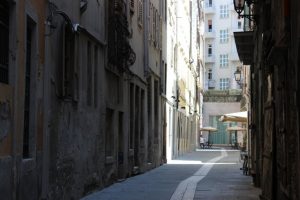 Via Beccherie è una delle più antiche strade della città. Nel 1754, venne costruito nei pressi un nuovo macello comunale e questa strada venne destinata ai venditori di carne.
Via Beccherie è una delle più antiche strade della città. Nel 1754, venne costruito nei pressi un nuovo macello comunale e questa strada venne destinata ai venditori di carne.
L’ultimo tratto di via Beccherie, verso l’attuale largo Riborgo, venne distrutto nel 1934 e al suo posto fu costruita, nel 1938, la Casa del Fascio, l’attuale Questura.
Via del Ponte corre da via Beccherie a Piazza Vecchia e fino al 1749 c’era un ponte in legno che attraversava il Canale della Portizza, detto Canale “Piccolo” o “del Vino”, dove si inoltravano le imbarcazioni da carico.
Piazza Vecchia si contraddistingueva da Piazza Nuova, la piazza situata dietro il palazzo del Comune che in futuro diventerà prima Piazza Grande e poi Piazza dell’Unità d’Italia.
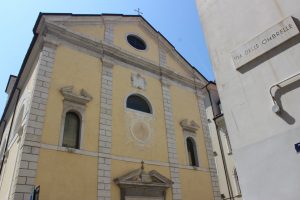 Piazza Vecchia un tempo era nota come Piazzetta del Rosario per la presenza di una confraternita di cittadini devoti che,nel 1613 chiesero la costruzione di una cappella detta del Rosario che per le leggi di Giuseppe II, fu chiusa nel 1784 e venduta alla Comunità evangelica di Cofessione Augustana, la quale ne mutò il titolo dedicandola alla SS. Trinità. Il fregio con dentro il triangolo e l’occhio, emblema del mistero della Santissima trinità. è ancora presente sulla facciata e sull’arco del presbiterio. nel 1869 il Comune demolita la chiesa di San Pietro, cappella comunale, la riacquistò destinandola a nuova cappella civica, facendo costruire in cambio la chiesa di Largo Panfili.
Piazza Vecchia un tempo era nota come Piazzetta del Rosario per la presenza di una confraternita di cittadini devoti che,nel 1613 chiesero la costruzione di una cappella detta del Rosario che per le leggi di Giuseppe II, fu chiusa nel 1784 e venduta alla Comunità evangelica di Cofessione Augustana, la quale ne mutò il titolo dedicandola alla SS. Trinità. Il fregio con dentro il triangolo e l’occhio, emblema del mistero della Santissima trinità. è ancora presente sulla facciata e sull’arco del presbiterio. nel 1869 il Comune demolita la chiesa di San Pietro, cappella comunale, la riacquistò destinandola a nuova cappella civica, facendo costruire in cambio la chiesa di Largo Panfili.
La denominazione di Via delle Ombrelle, da Via Beccherie a Piazza Vecchia, deriva dalla presenza della dimora di un bresciano dedito alla riparazione di ombrelli: Giacomo Malgarini.
In via Malcanton fino al 1753 c’erano le mura dell’antica Trieste che in questa strada formavano un angolo detto in dialetto “canton” e poichè era frequentata da malviventi da qui il nome di Malcanton.
Le vie del quartiere sono tuttora sede di negozi e di professioni tipiche dell’antiquariato, della vendita e del restauro di mobili, suppellettili e libri nonchè ristoranti e pub caratteristici.

